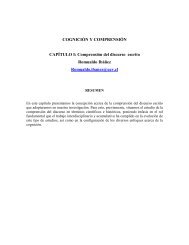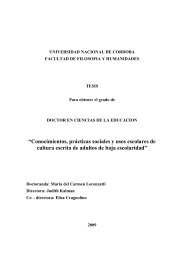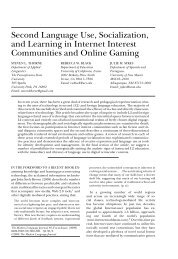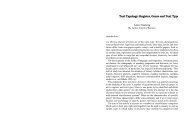Syntactic Structures
Syntactic Structures
Syntactic Structures
You also want an ePaper? Increase the reach of your titles
YUMPU automatically turns print PDFs into web optimized ePapers that Google loves.
36 SYNTACTIC STRUCTURES<br />
(22) (a) the - liner sailed down the - river<br />
(b) the - tugboat chugged up the - river<br />
(23) the - liner sailed down the and tugboat chugged up the - river.<br />
Similarly, if X and Y are both constituents, but are constituents of<br />
different kinds (i.e., if in the diagram of the form (15) they each have<br />
a single origin, but this origin is labelled differently), then we cannot<br />
in general form a new sentence by conjunction. For example, we<br />
cannot form (25) from (24a-b).<br />
(24) (a) the scene - of the movie - was in Chicago<br />
(b) the scene - that I wrote - was in Chicago<br />
(25) the scene - of the movie and that I wrote - was in Chicago<br />
In fact, the possibility of conjunction offers one of the best criteria<br />
for the initial determination of phrase structure. We can simplify<br />
the description of conjunction if we try to set up constituents in<br />
such a way that the following rule will hold:<br />
(26) If S1 and S2 are grammatical sentences, and S1 differs from S2<br />
only in that X appears in S1 where Y appears in S 2 (i.e.,<br />
S 1 = .. X.. and S2 = .. Y. .), and X and Y are constituents of<br />
the same type in S 1 and S2, respectively, then S 3 is a sentence,<br />
where S3 is the result of replacing X by X + and + Y in S1<br />
(i.e., S3 = .. X + and + Y..).<br />
rapid speech, etc. Such features normally mark the reading of non-grammatical<br />
strings. The most reasonable way to describe this situation would seem to be by<br />
a description of the following kind : to form fully grammatical sentences by<br />
conjunction, it is necessary to conjoin single constituents; if we conjoin pairs of<br />
constituents, and these are major constituents (i.e., 'high up' in the diagram<br />
(15)), the resulting sentences are semi-grammatical; the more completely we<br />
violate constituent structure by conjunction, the less grammatical is the resulting<br />
sentence. This description requires that we generalize the grammaticalungrammatical<br />
dichotomy, developing a notion of degree of grammaticalness.<br />
It is immaterial to our discussion, however, whether we decide to exclude such<br />
sentences as "John enjoyed and my friend liked the play" as ungrammatical,<br />
whether we include them as semi-grammatical, or whether we include them as<br />
fully grammatical but with special phonemic features. In any event they form<br />
a class of utterances distinct from "John enjoyed the play and liked the book,"<br />
etc., where constituent structure is preserved perfectly; and our conclusion that<br />
the rule for conjunction must make explicit reference to constituent structure<br />
therefore stands, since this distinction will have to be pointed out in the grammar.<br />
LIMITATIONS OF PHRASE STRUCTURE DESCRIPTION 37<br />
Even though additional qualification is necessary here, the grammar<br />
is enormously simplified if we set up constituents in such a way that<br />
(26) holds even approximately. That is, it is easier to state the<br />
distribution of "and" by means of qualifications on this rule than<br />
to do so directly without such a rule. But we now face the following<br />
difficulty: we cannot incorporate the rule (26) or anything like it it<br />
a grammar [E, F] of phrase structure, because of certain fundamental<br />
limitations on such grammars. The essential property of rule<br />
(26) is that in order to apply it to sentences S 1 and S2 to form the<br />
new sentence S3 we must know not only the actual form of S<br />
and S2 but also their constituent structure — we must know not only<br />
the final shape of these sentences, but also their 'history of derivation.'<br />
But each rule X-> Y of the grammar [E, F] applies or fails<br />
to apply to a given string by virtue of the actual substance of this<br />
string. The question of how this string gradually assumed this form<br />
is irrelevant. If the string contains X as a substring, the rule X-> Y<br />
can apply to it; if not, the rule cannot apply.<br />
We can put this somewhat differently. The grammar [E, F] can<br />
also be regarded as a very elementary process that generates<br />
sentences not from "left to right" but from "top to bottom".<br />
Suppose that we have the following grammar of phrase structure:<br />
Then we can represent this grammar as a machine with a finite<br />
number of internal states, including an initial and a final state. In<br />
its initial state it can produce only the element Sentence, thereby<br />
moving into a new state. It can then produce any string Y 1such that<br />
Sentence -> Y 1 is one of the rules of F in (27), again moving into a<br />
new state. Suppose that Yi is the string ... Xj ... Then the machine<br />
can produce the string ... ... by "applying" the rule Xj -> Yj.<br />
The machine proceeds in this way from state to state until it finally<br />
produces a terminal string; it is now in the final state. The machine<br />
thus produces derivations, in the sense of §4. The important point






